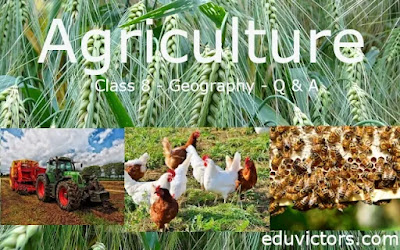CBSE Class 8 - Geography - Agriculture (Questions and Answers)
Book: Resource and Development
Q1: What is agriculture?
Answer: Agriculture is a primary activity that includes growing crops, vegetables, fruits, flowers and rearing livestock. It is connected with the extraction and production of natural resources.
Q2: Give a one-word definition to the following 'cultures'.
(a) Raising crops and rearing livestock.
(b) Rearing of silkworms and silk production.
(c) Breeding of fish.
(d) Cultivation of grapes.
(e) Growing vegetables, flowers and fruits.
Answer:
(a) Agriculture
(b) Sericulture
(c) Pisciculture
(d) Viticulture
(e) Horticulture
Q3: Name the factors influencing agriculture.
Answer: The factors that influence agriculture include soil, climate, topography, population etc.
Q4: What is Subsistence Farming?
Answer: Subsistence farming is a group of practices to meet the needs of the farmer’s family and needs less technology and labour.
Q5: What is shifting cultivation? What are its disadvantages?
Answer: Shifting cultivation is also known as Slash-and-burn cultivation.
Features of shifting cultivation are:
ⅰ It is a type of farming activity that involves clearing a land plot by cutting down trees and burning them.
ⅱ The ashes are then mixed with the soil and crops are grown.
ⅲ After the land has lost its fertility, it is abandoned.
ⅳ The farmers then move to a new place.
Disadvantages of shifting cultivation are:
ⅰ Leads to deforestation
ⅱ Loss of fertility of a particular land
ⅲ Leads to Soil erosion
ⅳ Burning of trees causes air pollution
Q6: What is Nomadic herding?
Answer:
⒜ Herdsmen move from place to place with their animals for fodder and water along defined routes.
⒝ They sell their milk and flesh in the market and get things for survival.
⒞ Sheep, yak and goats are the herding animals.
Q7: Define plantation agriculture.
Answer: Plantations are a type of commercial farming where single crops of tea, coffee, sugarcane, cashew, rubber, banana or cotton are grown.
① Large amount of capital is required.
② The produce may be processed on the farm itself or in nearby factories.
③ The development of a transport network is thus essential for such farming.
④ Major plantations are found in the tropical regions of the world.
⑤ Rubber in Malaysia, coffee in Brazil, tea in India and Sri Lanka are some examples.
Q8: Name the fibre crops and mention the climatic conditions required for their growth.
Answer: Jute and Cotton are fibre crops.
① The climatic conditions necessary for the growth of Jute are high temperature, heavy rainfall and high humidity.
② Similarly, high temperature, light rainfall, bright sunshine are required for the growth of cotton.
Q9: In India agriculture is a primary activity. Give reasons.
Answer: Agriculture is a primary activity because many regions in India have fertile land that is favourable for agriculture.
⒜ Two-thirds of the Indian population still depends on agriculture.
⒝ This is mainly because of the lack of literacy among the people.
⒞ Hence, India being a densely populated country requires large scale production of food to fulfil the people needs.
Q10: Why are different crops grown in different regions?
Answer: Different crops are grown in different regions because growing the crops depends on factors such as favourable topography of soil, the demand of produce, type of climate, amount of rainfall, technology and labour.
Q11: Distinguish between primary activities and tertiary activities
| Primary activities | Tertiary activities |
|---|---|
| Primary activities are related to the production and extraction of natural resources such as fishing, agriculture, mining. | Tertiary activities are those that provide support to primary and secondary sectors in carrying out their activities like transportation, banking etc. |
| Subsistence farming | Intensive farming |
|---|---|
| 1. Subsistence farming is a type of farming that the farmer practices to meet the needs of his family. | 1. In intensive subsistence agriculture, the farmer cultivates a small plot of land using simple tools and more labour. |
| 2. The cultivation of crops is done for personal consumption. | 2. Rice, wheat, maize, pulses and oilseeds are the commercial crops grown in this type of farming. |
| 3. It involves low levels of technology and household labour to produce a small output. | 3. Intensive subsistence agriculture is prevalent in the thickly populated areas of the monsoon regions. |
Geography - Ch 1 - Resources (Q & A)
Geography - Ch 2 - Land Soil, Water, Natural Vegetation and Wildlife
Geography - Land and Soil (Worksheet)
List Of Important Dams In India

No comments:
Post a Comment
We love to hear your thoughts about this post!
Note: only a member of this blog may post a comment.